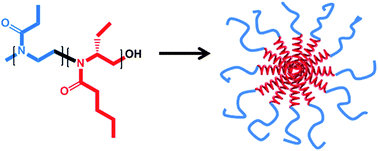Self-assembly of chiral block and gradient copolymers†
Abstract
Chiral micelles have a high potential for targeted

* Corresponding authors
a Laboratory of Macromolecular Chemistry and Nanoscience, Eindhoven University of Technology, P. O. Box 513, Eindhoven, The Netherlands
b
Dutch Polymer Institute (DPI), P. O. Box 902, Eindhoven, The Netherlands
E-mail:
ulrich.schubert@uni-jena.de
c Laboratory of Organic and Macromolecular Chemistry (IOMC), Friedrich Schiller University Jena, Humboldtstrasse 10, Jena, Germany
d Jena Center for Soft Matter (JCSM), Friedrich Schiller University Jena, Humboldtstrasse 10, Jena, Germany
e Bio and Soft Matter (BSMA), Institute of Condensed Matter and Nanoscience (IMCN), Université catholique de Louvain, Place L. Pasteur 1, Louvain-la-Neuve, Belgium
f
Supramolecular Chemistry Group, Department of Organic Chemistry, Ghent University, Krijgslaan 281 S4, Ghent, Belgium
E-mail:
richard.hoogenboom@ugent.be
Chiral micelles have a high potential for targeted

 Please wait while we load your content...
Something went wrong. Try again?
Please wait while we load your content...
Something went wrong. Try again?
M. M. Bloksma, S. Hoeppener, C. D'Haese, K. Kempe, U. Mansfeld, R. M. Paulus, J. Gohy, U. S. Schubert and R. Hoogenboom, Soft Matter, 2012, 8, 165 DOI: 10.1039/C1SM06595E
To request permission to reproduce material from this article, please go to the Copyright Clearance Center request page.
If you are an author contributing to an RSC publication, you do not need to request permission provided correct acknowledgement is given.
If you are the author of this article, you do not need to request permission to reproduce figures and diagrams provided correct acknowledgement is given. If you want to reproduce the whole article in a third-party publication (excluding your thesis/dissertation for which permission is not required) please go to the Copyright Clearance Center request page.
Read more about how to correctly acknowledge RSC content.
 Fetching data from CrossRef.
Fetching data from CrossRef.
This may take some time to load.
Loading related content
